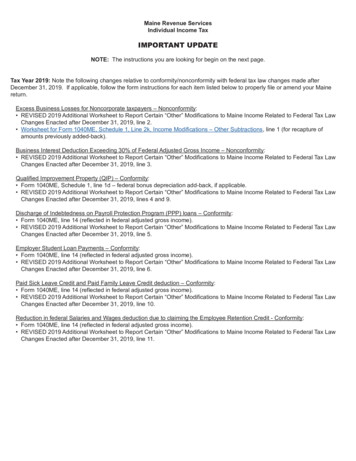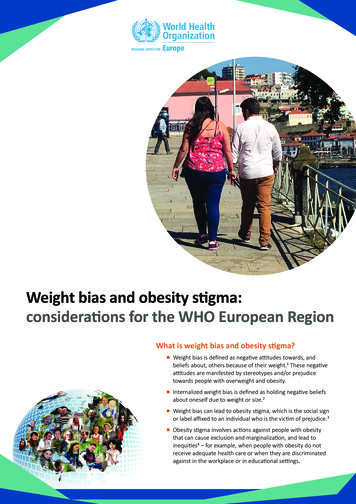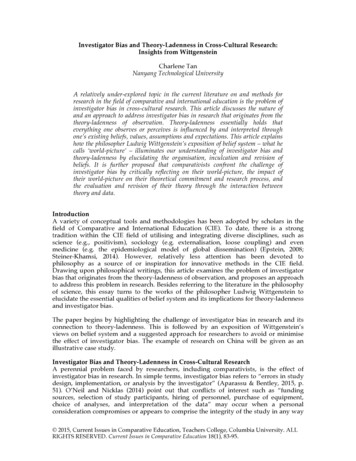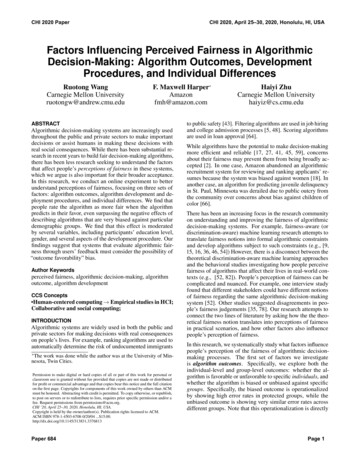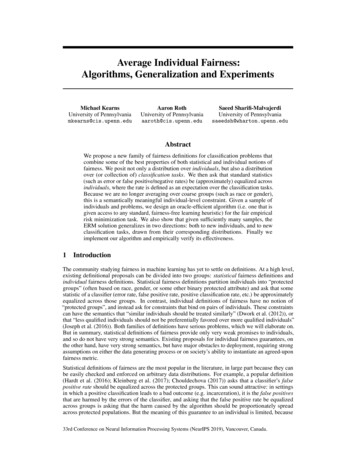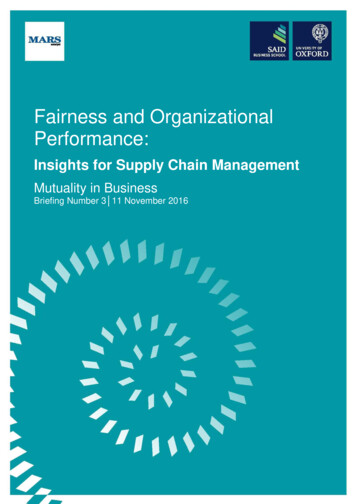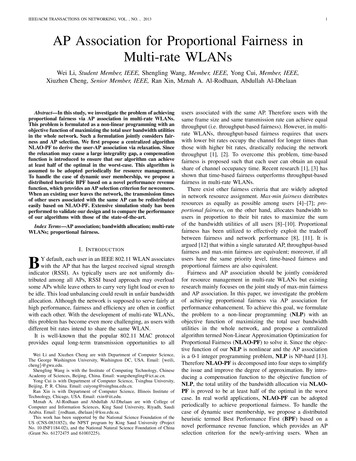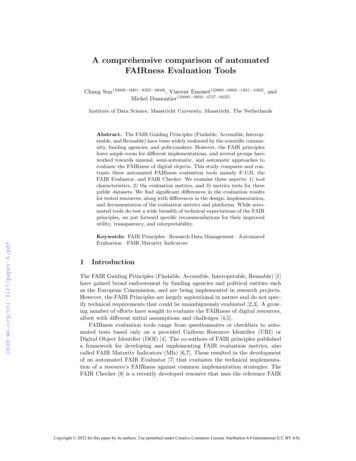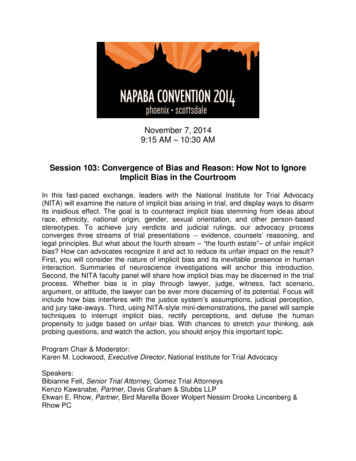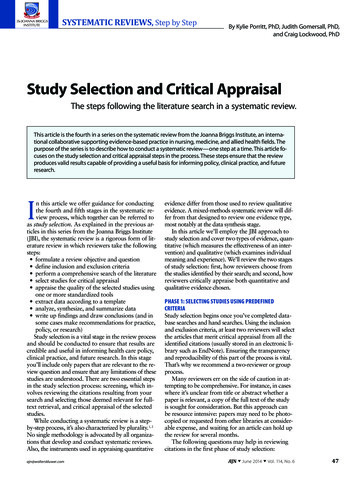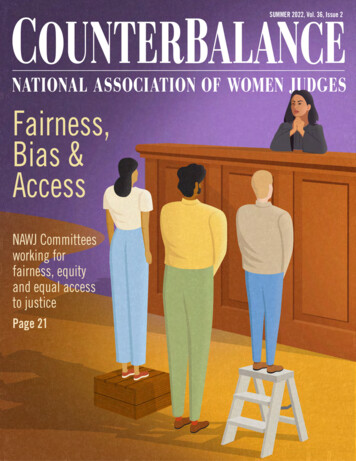
Transcription
SUMMER 2022, Vol. 36, Issue 2Fairness,Bias &AccessNAWJ Committeesworking forfairness, equityand equal accessto justicePage 21
SUMMER 20221MISSIONNAWJ’s mission is to promote the judicial roleof protecting the rights of individuals under therule of law through strong, committed, diversejudicial leadership; fairness and equality in thecourts; and equal access to justice.BOARD OF DIRECTORSEXECUTIVE COMMITTEEPRESIDENTHon. Elizabeth Allen WhiteSuperior Court of California, County of Los AngelesPRESIDENT-ELECTHon. Toni ClarkePrince George’s County Circuit Court, MarylandVICE PRESIDENT, DISTRICTSHon. Pamela WashingtonAnchorage District Court, AlaskaVICE PRESIDENT, PUBLICATIONSHon. Mimi TsankovNational Association of Immigration Judges,New York2 President's Message3 VP of Publications’ Message4 Executive Director's Message5 Understanding Implicit Bias is aMatter for Mandatory CLE7 Fairness and Access Starts withEmpathy21 Committees! Committees!Committees!22333435District NewsDistrict & Status DirectorsSponsorsNew Members9 22nd Annual Midyear Meeting12 A Life-changing Experience13 Fairness & Access Committee16 Our One CommunityRetired judge touches the lives ofwomen a world awaySECRETARYCol. Linda Murnane,United States Air Force (Ret.)Beavercreek, OhioTREASURERHon. Karen Sage299th District Court of Texas, Travis CountyIMMEDIATE PAST PRESIDENTHon. Karen Matson DonohueKing County Superior Court, Seattle, WashingtonCOUNTERBALANCE is published by:National Association of Women JudgesPROJECTS COMMITTEE CHAIRHon. Brandy Mueller1725 Eye St. NW, Suite 300, Washington, DC 20006Phone: 202 393 0222Fax: 202 393 0125County Court at Law #6, Austin, TexasE-mail: nawj@nawj.orgFINANCE COMMITTEE CHAIRHon. Anita Josey-HerringWeb: www.nawj.orgSuperior Court of the District of ColumbiaSTAFFEXECUTIVE DIRECTORLaurie Hein Denham, CAEDIRECTOR OF DEVELOPMENTFrancie Teer, CFREOPERATIONSBrian GorgMEMBERSHIP COORDINATORJanelle Mihoc 2022 National Association of Women Judges. All rights reserved.Views and opinions expressed are solely those of the authors and contributors,and do not necessarily represent those of the NAWJ.
President’s Messagehis issue of Counterbalance isdedicated to you the members.The news is sometimes grim and itseems as if we’re not progressingin the right direction but we at NAWJ havestayed focused on our mission statementand achieved much in the last year.Our effortsat increasingdiversity on thebench have beenrewarded with theconfirmation ofJustice KetanjiBrown Jackson tothe United StatesSupreme Court.After navigating the pandemic, wesuccessfully held two in person meetings,the Annual Conference in Nashville, whichwas great fun and so inspiring, followedby our midyear meeting in WashingtonDC at which we celebrated Women JudgesDay and honored three Afghan WomenJudges with NAWJ memberships. Effortsare ongoing to help these women getfellowships to LLM programs or pursueother opportunities in the legal profession.Our committees are focused on improvingfairness and equity in the law. OurDomestic Violence Committee has beenworking cooperatively with the AmericanLaw Institute seeking to revise theirproposed Model Penal Code to adopt adefinition of “consent” in sexual assaultcases which does not put the burden ofproof on the victim to show lack of consent.Our efforts at increasing diversity onthe bench have been rewarded withthe confirmation of Justice KetanjiBrown Jackson to the United StatesSupreme Court. In addition, womenof color continue to rise to positions ofprominence. Justice Patricia Guerrero, adaughter of immigrants became the firstLatina to join the California SupremeCourt, and Justice Lisa Holder Whitebecame the first Black woman to serve onthe Illinois Supreme Court.NAWJ’s Master Calendar was launchedon April 1 and a review of the activitiesSUMMER 2022of our members, Districts and Committeesdemonstrates just how active our organizationis. I encourage you to check out the calendarand become a part of the amazing workNAWJ accomplishes through its Districts andCommittees.We have also been active in producingwebinars: “Pathways to the AdministrativeJudiciary” by our Administrative JudiciaryCommittee, “Immigration Update” by ourImmigration Committee and “Racial Disparityin the Courts – Strategies to Combat RacialInequality in the Courts and CriminalJustice System” by our Access and FairnessCommittee thanks to a grant from the StateJustice Institute.We are initiating a collaboration with theNational Judicial College to share educationalprograms and sponsorships.Make sure to register for our 44th AnnualConference to be held at the Westin BookCadillac Detroit to be held from October 1922. The conference promises to offer amazingeducational programming, opportunities tonetwork not to mention dance to the Motownmusic!I am grateful to all of you for the work that youdo and for continuing to remain positive as weseek to promote the judicial role of protectingthe rights of individuals under the rule of lawthrough strong committed, diverse judicialleadership, fairness and equality in the courtsand equal access to justice.Hon. Elizabeth WhitePresident2
SUMMER 2022Vice President of Publications Messagehank you to all who submittedarticles for this issue ofCounterbalance. The SummerCounterbalance issueembodies NAWJ President JudgeWhite’s theme of inclusivity as a meansof effecting change. We’ve focusedthis issue on the grassroots work ourmembers are doing through committeeengagement. With more than 25 activegroups covering everything from theneeds of “Women in Prisons” andHuman Trafficking, to Rural Courtsand Diversity and Inclusion, our judgesare leading their communities andimproving access to justice for all.I encourage eachof our members toshare activities,scholarly articles,and ideas withus so that NAWJ’sCounterbalanceissues will continueto inspire and helpour organizationmaintain itshigh standardsof publicationexcellence.Judge Finlay made 50 years ago, shehas launched a global partnershipserving the needs of villagers in aremote region of Tanzania. Thisstory is inspirational and revealsthe meaningful work that NAWJjudges continue doing once they turntheir attention away from the benchactivities.It is my distinct honor to edit thisCounterbalance issue, and to keep youinformed and connected across ourdistricts and across the country. It is ajoint effort, and impossible to achievewithout the steady leadership of LaurieDenham, NAWJ’s Executive Director,and her skilled team includingJanelle Mihoc. I encourage eachof our members to share activities,scholarly articles, and ideas with us sothat NAWJ’s Counterbalance issueswill continue to inspire and helpour organization maintain its highstandards of publication excellence.This issue presents an article by Hon.Heidi Pasichow, Committees Liaison tothe NAWJ Board. As she explains, theCommittees provide a framework and anopportunity for all association membersto contribute dynamically towardfulfilling the Association’s mission to“promote the judicial role of protectingthe rights of individuals under the ruleHon. Mimi Tsankovof law through strong, committed,Vice President of Publicationsdiverse judicial leadership; fairness andequality in the courts; and equal accessto justice.” This issue spotlights theDISCLAIMER: The author is the President of theNational Association of Immigration Judges. The viewsFairness and Access Committee andhere do not necessarily represent the officialmember Hon. Diana L. Leyden, Special expressedposition of the United States Department of Justice,Trial Judge, U.S. Tax Court, writesthe Attorney General, or the Executive Office forImmigration Review. The views represent the author’sabout the role that empathy plays in thepersonal opinions, which were formed after extensivepractice of law and in the courtroom.consultation with the membership of NAIJ.She presents the thesis that practicingempathy makes us better judges, whichis a key mission of the Fairness andAccess Committee. Finally, in thisissue, Supervising Deputy AttorneyGeneral for the California Departmentof Justice, Hon. Jodi Cleesattle, providesa profile of the work of retired San DiegoSuperior Court Judge Susan Finlay.As she explains, through contacts3
SUMMER 2022Executive Director Messaget has been exciting to experiencein-person national and districtevents. As you will read in this issueof Counterbalance, the MidyearMeeting was a great time of educationand fellowship. We also encounteredevery season in three days, from hot andsunny, to rain and on the last day snow!Many Districts have begun their inperson programming and makingan impact in their communities. The2022 Annual Conference Committeeis meeting regularly to bring you thecutting-edge education NAWJ isknown for, and a diverse selection ofentertainment!We continueto seek grantopportunities andwelcome your ideas. Ifyou have a potentialproject with a nationalexposure, pleasecontact me.Internally, we have developed a muchrequested Master Calendar to giveyou access to committee meetings.Simply click this link and contact thecommittee chair of any meetings youwould like to attend. An online formis coming soon to make it simpler foryou to join a committee. Now that thecourts have re-opened, we know thatyou are busier than ever, and we wantto make volunteer opportunities asseamless as possible.The NAWJ Legacy Society launchedthis spring, and I am grateful to thoseof you who are already participating.This program will ensure NAWJis sustainable into the future. Wecontinue to seek grant opportunitiesand welcome your ideas. If you havea potential project with a nationalexposure, please contact me.This month marks my one-yearanniversary as your permanentexecutive director. I am thankful foryour support and encouragement andfor the opportunity to serve NAWJ.Laurie Hein Denham, CAEExecutive Director4
SUMMER 2022UnderstandingImplicit BiasIs a Matter forMandatory CLEI recently co-chaired the National Associationof Women Judges’ committee on RacialDisparities in the Courts and had a chanceto interview the Honorable Judge BerniceDonald on the 6th Circuit United States Courtof Appeals who was invited to speak. I metJudge Donald over 12 years ago when she waspresenting a breakout session on implicit bias ata joint Alaska Bar / Judicial Conference at theDena’ina Center. Hundreds of lawyers andjudges attended the conference but less than adozen people attended Judge Donald’sbreakout session on this important and emergingtopic. I thought then as I do now, “ how do youget lawyers and judges to realize the impact ofimplicit bias in the legal profession?”By Hon. Pamela Scott WashingtonAnchorage District Court JudgeVice President of Districts, NAWJ5
SUMMER 2022am an advocate for implicit biaseducation and a proponent ofmandatory continuing legaleducation on implicit bias. In my 25plus years as a member of Alaska’s legalcommunity, I have personally experiencedhow implicit biases can narrow a person’svision and influence their behaviors. I alsobecame keenly aware of my own biasesand remain vigilant and intentional toeliminate them from my judicial discretionand decisions. As co-chair of the AlaskaSupreme Court’s Fairness, Diversity, andEquality Commission and member of theCultural Competency subcommittee, I aminvolved with a team of judicial officersworking to ensure ongoing implicit biaseducation and training is provided to allAlaska judges. It is not just the judiciary,but the integrity of every part of oursystem of justice is under scrutiny. Asmembers of the legal profession, thisshould concern us.I believe there are two main barriersto making mandatory CLE credits forcultural competency, diversity, inclusion,and implicit bias education. One barrier is“race.” The other barrier is “mandatory.”The issue of race has always been difficultto talk about, especially for those whoare members of the predominant group.The predominant group that makes up93.4% of the Alaska Bar membership maybe adversely triggered by words like race,critical race theory, white privilege, andracial injustice, and may think of implicitbias in the same way. Implicit bias is notan accusation of racism. In fact, implicitbias is not about racism, or sexism, orageism, or any other “isms.” It is aboutyour subconscious brain and mentalassociations. Judge Donald explainedthat implicit bias is the process by whichthe brain uses well established mentalassociations to operate without ourawareness, without intention, or control.“It is that human computer programthat is working in the background that isinfluencing our actions and our thoughtseven when we are not aware of it andit is contrary to our announced anddeeply held values.” These associationsare a product of our backgrounds, livedexperiences, our in groups, and our outgroups. As members of the Bar, evenwhen we believe we are fundamentallyfair at our core, we cannot disregard thefact that bias is baked in. Unbeknownstto us, our brains are sorting informationand making conclusions that compromisethe good judgment of fundamentally fair,well intentioned people. Consider that anadverse reaction to training on implicitbias may well be an indication of implicitbias at work in us.In the introductory statement of theAlaska Rules of Professional conduct, weare reminded that lawyers should seekimprovement of the law, access to the legalsystem, the administration of justice, andthe quality of service rendered by the legalprofession. If we know the influence ofimplicit bias creates deficiencies in theadministration of justice, then we shouldact to minimize these deficiencies inthe interests of living up to the ideals ofequal justice for all. We are all vulnerableand when we know we have a blind spotthat can be obstructing our view, wemust be intentional about removing theobstruction so we can see clearly.The other barrier to overcome in supportof imposing a mandatory CLE on implicitbias is “mandatory.” Members of the Barwould probably not oppose voluntaryCLEs addressing such topics, but prefer toretain the right to choose. However, this ismore than a matter of personal choice. It isa matter of professional competency.Mandatory requirements reflect what wevalue as members of the legal community.We value education and professionalcompetency. It is the reason why it ismandatory that lawyers graduate from anaccredited law school, pass a Bar Exam,6and engage in mandatory continuing legaleducation. Rule 1.1 of the Alaska Rulesof Professional Conduct articulates thisvalue—a lawyer shall provide competentrepresentation to a client. Competentrepresentation requires effectivecommunication with a very diversepopulation. Effective communicationrequires a level of cultural competencyand a sensitivity to that human computerprogram working in the backgroundunconsciously influencing our actionsand thoughts.We already recognize the importanceof removing bias from the law. When ajudge knows they have a personal bias orprejudice concerning a party or a party’slawyer, Cannon 3E(1)(a) of the Code ofJudicial Conduct, states the judge shalldisqualify himself or herself when ajudge’s impartiality might be reasonablyquestioned. Unconscious biases aremore important because they may havean impact on impartiality yet never berecognized in lawyering or judicialdecision-making. We value professionalcompetency and we make what we value“mandatory.” Unconscious bias is anethical issue and should be a mandatorypart of continuing legal education.Other professions are recognizing theneed for mandatory implicit bias andcultural competency education andtraining. Professional organizationssuch as Joint Commission and LiaisonCommittee on Medical Education requiretraining in implicit bias for accreditation.Implicit bias training is mandatory for allnurses in California and Michigan. Mentaland behavior health clinicians are requiredto complete mandatory education andtraining hours on cultural competencyfor licensure. As of November 15, 2019,Missouri requires attorneys to completethree (3) Ethics credits every year, one(1) of which must cover topics addressingCultural Competency, Diversity, Inclusion,Continued on page 8
SUMMER 20227“As judges we have privileges— wealth, education, status- that most whoappear before us do not. If we perceive the circumstances of a case fromour privileged vantage point, how can we truly be neutral?”Fairness and Access Start withecently, I had a conversationwith a dear colleague, NellNewton, who is the currentinterim dean of the Universityof Miami Law School. Nell has been adean in several other schools, and we werediscussing the role of empathy in practicinglaw. She mentioned that she keeps on herdesk a sign that says, “It’s not all about me.”I realized that such a saying really is aboutreminding us to practice empathy.I began thinking about how practicingempathy makes us better judges. Inresearching articles about the topic, Istumbled upon Professor Rebecca K. Lee’sarticle “Judging Judges: Empathy as theLitmus Test for Impartiality, 82 U. Cin.L. Rev. 145 (2013). From her article Iconcluded that practicing empathy makesBy Hon. Diana L. Leyden,Special Trial Judge, U.S. Tax Courtme a better judge because it: (1) helps meremain neutral; (2) helps me adhere to myethical duty to be impartial; and (3) aidsme from jumping to conclusions that arecomfortable but may ignore how a litigantsees the law and the circumstances thatbrough him/her/them before me.Some may incorrectly believe that
SUMMER 2022practicing empathy is ruling withemotion. As Professor Lee points outempathy consists of both mental andemotional components. Thus, empathyis not pure emotion but rather a form ofcognitive understanding. It provides usEmpathywith the capacity to better comprehendanother’s perspective through bothknowledge and feeling. It is more thanjust noting your similarities with anddifferences from the person who appearsbefore you.Practicing empathy requires work onour parts. Empathy is the ability toperceive the view of the world or situationfrom another person’s perspective. AsProfessor Lee writes, empathy’s goal “isnot to encourage conscious generositytoward one side, per se, but rather toensure that a litigant does not unfairlybenefit from unconscious or automaticcredibility simply because a judge betterunderstands, or is more familiar with,that party’s story.” 82 U. Cin. Rev. at153. Practicing empathy allows us tostrive to be neutral because we see thecircumstances of the case before us froma different vantage point. As judgeswe have privileges- wealth, education,status- that most who appear before us donot. If we perceive the circumstances ofa case from our privileged vantage point,how can we truly be neutral?Empathy also assists us in remainingimpartial. Looking at our involvementin a case from the lens of Joe and JanePublic might show us that they perceiveour involvement as assisting one sideover another, thereby assisting us instepping away from a case and remainingimpartial.Empathy may assist us in making bettersummary adjudications. We may defaultto deciding a summary judgment motionbased on how we have decided similarissues before. Practicing empathy helpsus consider the facts in a summaryjudgment motion anew by consideringthe facts in the motion from differentlenses and avoid an automatic applicationof the law.Professor Lee’s article suggests thatpracticing empathy tamps down beingaffected by similarities and differenceswith litigants and instead taps into sharedfeelings and aspirations which allows usto see disputes through a different lens. Irecommend Professor Lee’s article to alljudges and hope that our committee maybe able to develop training materials orpanels to explore how judges can practiceempathy and how doing so may assistthem in being the best judges they can.Diana L. Leyden is a Special TrialJudge. Born in New York; Union College,Schenectady, NY, B.A. magna cumlaude,1978; UConn Law School, Hartford,CT, J.D. 1982; Georgetown University LawCenter, LL.M. Taxation 1984. Admitted toConnecticut Bar (1982), District of ColumbiaBar (1982, inactive) and Massachusetts Bar(1985, inactive); Admitted to U.S. Court ofFederal Claims (1983); United States DistrictCourt for the District of Connecticut, 2001;United States Court of Appeals for the SecondCircuit, 2003; Member of the American BarAssociation, Tax Section; Recipient of theAmerican Bar Association Tax Section JanetSpragens Pro Bono Award (2005); formerchair of the ABA Tax Section Low IncomeTaxpayer Committee; Connecticut Departmentof Revenue Services (1995-1997); UConn LawSchool Tax Clinic (1999-2015); New York CityDepartment of Finance Taxpayer Advocate(2015-2016). Appointed Special Trial Judge ofthe United States Tax Court on June 20, 2016.Understanding Implicit Bias Is a Matter for Mandatory CLEContinued from page 6or Implicit Bias. These organizations foundvalue in having their members recognizeand address their implicit biases, buildcultural competency, and appreciate theimportance of diversity and inclusion, sothey made training mandatory.Our failure as a profession to acknowledgeour own deficits has had its share ofunfortunate consequences. In 1978, theIndian Child Welfare Act was enactedto correct the most longstandingand egregious removal practicesspecifically targeting Nativechildren. It was not just socialworkers and case workers, but also judges,lawyers, and guardians-ad- litem werepreferring non-Native placements forNative children. Presumably these wereall good hardworking professionals.Could that human computer working inthe background lead a person to concludethat only a non-Native placement was inthe best interests of a Native child? It isclear unconscious biases played a role insystem abuses directed at Native children.Mandatory continuing legal education oncultural competency, diversity, inclusion,and implicit bias will give the legalprofession an opportunity to regain some8of the ground the legal profession has lostthrough the years to unconscious biasesand move towards regaining and buildingthe public trust in the justice system.Originally published in theJanuary – March 2022 Alaska Bar RagJudge Pamela Scott Washington is cochair of the Alaska Supreme Court’s Fairness,Diversity & Equality Commission and serveson the Cultural Competency Committee. JudgeWashington presides over the CoordinatedResource Project (Mental Health Court)in Anchorage and the Criminal and Civilcalendar in Sand Point, Alaska
SUMMER 2022Day 1 of the conferencekicked off with a BoardMeeting, followed bythe “Planting the Seed”program to mentorlaw students. Over 23students participatedfrom five law schools.By Kelsea Jeonembers and supporters ofthe National Associationof Women Judges (NAWJ)gathered from March 1012, 2022 for the 22nd Annual MidyearMeeting at the Renaissance ArlingtonCapital View Hotel. It was a joyousoccasion, and for many judges, the firsttime they got to see one another sincethe start of the COVID-19 pandemic. Atthe previous in-person NAWJ gathering,the 2021 Annual Meeting in Nashville,President Hon. Elizabeth A. White (ret.)shared that NAWJ’s theme of the year is“Effecting Change: Drawing from ourPast and Embracing our Future.” Theevents at this year’s Midyear reflected thattheme.Day 1 of the conference kicked offwith a Board Meeting, followed bythe “Planting the Seed” program tomentor law students. Over 23 studentsparticipated from five law schools. During9the mentoring session, judges sharedtheir reflections about joining the bench,working in private practice and publicinterest, and balancing motherhoodand a successful career. Students cameaway from the session with insight frompioneers in the legal profession andcontact information to follow up if theywished to continue the conversation.Following the Law Student MentorshipProgram, the conference transitionedto its Opening Reception, celebratingthe International Day of Women Judges.President White shared remarks tobegin the conference, giving attendees apreview of the events to follow, and JudgeLisa Walsh introduced special guests,three Afghan Women Judges. Each of thethree Afghan Women Judges themselvesdelivered heartfelt remarks brieflydescribing their stories and expressingtheir gratitude for NAWJ members.
SUMMER 2022The next morning Jen Klein, theExecutive Director of the White HouseGender Policy Council, joined PresidentWhite for a Fireside Chat. They discussedthe work of the Gender Policy Counciland shared insight into how plans forgreater gender equality are turned intoprogress. A few notable highlights: OnMarch 16, 2022, Congress and PresidentBiden reauthorized the Violence AgainstWomen Act (VAWA), which was enactedin 1994 but expired in 2017. Notably,NAWJ was instrumental in helping passVAWA in 1994. NAWJ was the onlyjudicial organization to support thelegislation and joined the Senate JudiciaryCommittee staff and Legal Momentumto refine the provision’s language tomeet the concerns voiced by legislatorsand judges. Following the fireside chat,conference attendees asked questions,ranging from support from the federalgovernment for increased child andelder care funding and further efforts toevacuate women judges in Afghanistan.The Fireside Chat was followed bythe session, “Access to Justice in aVirtual World: Strategies to AddressProcedural and Substantive Impact andBuild Community Trust.” This paneldiscussed the role of digital innovationand experimentation within the courtsduring the pandemic and the importanceof research in ensuring that these digitalpolicies do not have an inappropriatesubstantive impact. Judge SamanthaJessner and Judge Catharine Easterlyprovided perspective about how theirrespective courts in Los Angeles andWashington D.C. have transitioned toremote hearings in 2020. Ms. MaliaBrink reflected the research angle ofthe transition to digital strategies andshared resources from organizations likethe American Bar Association and theNational Center for State Courts.10During the Plenary Luncheon, NAWJpresented Judge Vanessa Ruiz with theLady Justice Award for Humanitarian Aidto recognize her dedication and ongoingefforts to help evacuate women judgesin Afghanistan and many who are stillunable to leave the country.The speaker for the Plenary Luncheon wasMs. Julia Olson, the Executive Directorand Chief Counsel for Our Children’sTrust, the world’s only non-profitpublic interest law firm that exclusivelyrepresents youth in constitutional climatelawsuits. She discussed the organization’sappellate advocacy efforts and reviewedopinions and outcomes from recent casesacross the U.S. Despite the direness andimmediacy of the warming plant, Ms.Olson’s presentation left the audience,who all rose and delivered a standingovation, with a feeling of hope andoptimism for the future.
SUMMER 2022The afternoon sessions began with“Judges in Transition: What’s next aftera satisfying career on the bench? Willit be ADR, non-profit work, being agrandparent, or perhaps an author?”.Retired judges shared their perspectivesabout the post-bench transition andopportunities. Judge Mary White sharedinsights about the joy of spending moretime with her grandkids. Judge RandaTrapp reflected on joining privatejudging with JAMS. Judge BeverlyCutler described how she discoveredpurpose while doing pro bono work tohelp non-citizens who had served in themilitary obtain justice. Finally, JudgeBarbara Levenson detailed her journeyto becoming an author of fiction novels.During the question-and-answer session,judges shared their concerns aboutstarting anew after a fulfilling career on11the bench and turned to one another forsupport and camaraderie.with breakfast in which District 4 honoredJudge Irma Raker with the Edna ParkerAward. The final education sessionThe last session for the day was a panelon “Racial Disparity in the Courts:discussing “Self-Representation as Part of Strategies to Combat Racial Inequality inthe Civil Justice Reform Landscape: New the Courts and Criminal Justice System.”Opportunities for Judicial Leadership.”This training was funded by a grant fromMs. Katherine Alteneder of the Selfthe State Justice Institute and organizedRepresented Litigation Network, whoby Judge Pamela Washington, Judgealso moderated the access to justicePennie McLaughlin, Judge Cheryl Rios,in a virtual world panel, framed theJudge Maria Puente-Porras, and Judgediscussion by focusing on the importance Edwina Mendelson.of reforms around self-representedlitigations in the larger civil justiceAll in all, the 2022 NAWJ Midyearreform movement. Judge Doreen BoxerConference was a wonderful event thatprovided insights and guidelines aboutcaptured President Judge White’s themeethical considerations for judges whenof Effecting Change by Drawing Fromencountering self-represented litigants.our Past and Embracing our FutureMs. Maha Jeweid also contextualizedperfectly. Be it through the firesidereforms within a broader global legalchat with Ms. Jen Klein that recognizedempowerment movement and its goal ofNAWJ’s past efforts in helping passhelping individualsVAWA and the recent news about VAWA’sand communitiesreauthorization; the plenary luncheonknow, use, and shape where Ms. Julia Olson shared her effortsthe law. The day closed in fighting for our youths’ future bywith the Resourcetackling climate change in courts; theBoard meeting andjudges in transition panel where womeninformal dinnergave their fellow sisters-in-law candidgatherings aroundadvice and comfort about a life beyondArlington.the bench; or the access-to-justice panelsabout how our courts have adapted amidstOn Saturday, aCOVID-19 and how judges can adapt tosnowstorm brewed in the growing number of self-representedWashington, but thelitigants in court.conference continued.The last day beganThank you for the successful MidyearConference, and NAWJ hopes to see youat NAWJ’s 44th Annual Conference “AllRise: Standing up for Global Justice in theCity that Moved the World” in Detroit,Michigan this October.Kelsea Jeon is the Richard
SUMMER 2022 1 2 President's Message 3 VP of Publications' Message 4 Executive Director's Message Hon. Elizabeth Allen White 5 Understanding Implicit Bias is a Matter for Mandatory CLE 7 Fairness and Access Starts with Empathy 9 22nd Annual Midyear Meeting 12 A Life-changing Experience 13 Fairness & Access Committee 16 Our One Community Retired judge touches the lives of
